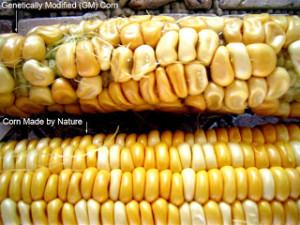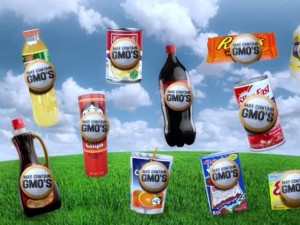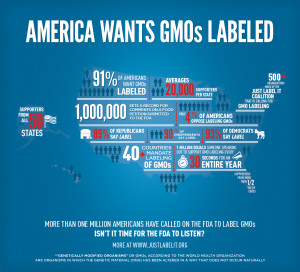GMOs for Newbies
GMOs for Newbies
Unless you’ve been hiding under a bush–not that there’s anything wrong with that, some days I’d prefer camping out under a bush–you’ve been hearing a lot about GMOs lately.
GMOs are in the news, online, all over your Facebook news feed and most likely they’re a topic of discussion on most Health & Wellness and Food Blogs that you follow, and, with good reason. You may wonder why this topic seemed to have appeared out of nowhere and you might also wonder why it is gaining such momentum. What’s the deal with GMOs?

WHAT EXACTLY ARE GMOs?
GMO stands for Genetically Modified Organism. It can also be referred to as GE- Genetic Engineering, or GM, Genetic Modification.
Simply put, “A GMO (genetically modified organism) is the result of a laboratory process of taking genes from one species and inserting them into another in an attempt to obtain a desired trait or characteristic, hence they are also known as transgenic organisms. This process may be called either Genetic Engineering (GE) or Genetic Modification (GM); they are one and the same.” (Source)
How exactly do scientists combine the DNA of one species with another? Well, in order for them to breach this natural barrier of DNA scientists must forcefully introduce the DNA of viruses and/or bacteria to infect the animal or plant cells.
Another way they can combine genes from different species of plants, animals and bacteria/viruses is that they coat the DNA with metal so they can “fire it” into millions of cells using a special gun. GMO Bt corn is produced using this process. When they use this gun they’re simply hoping that some of those genetically modified genes make it into the DNA of some of the cells they are trying to genetically modify.
They don’t even know if they’re firing the DNA into the right cells or where the DNA is going when they fire the foreign/altered gene into the cell. They can’t tell just by looking at it, so they fire in an antibiotic resistant marker gene, and it’s job is to produce a protein that renders the cell invincible to a normally deadly antibiotic. So after they shoot this gene into the cell, they add antibiotics killing almost all of the cells except the very few that have the GM gene construct functioning inside the DNA because that has rendered the cell invincible to that antibiotics and then they take those cells and clone them into the corn plant that produces the Bt toxin.
This corn is now regulated by the EPA and is considered a pesticide and not a food. This is the same corn that is being fed to livestock. This is the same corn that is going into processed foods. Corn chips anyone? (Source)
The result of this unstudied act of introducing the DNA of a foreign species into the genes from a plant or animal are genetically modified foods; plant based and animal based.
Another example of a genetically modified food would be tomatoes injected with fish genes to make the fruit resistant to frost. Spider genes injected into goats so that they would produce milk that contained spider web proteins in order to produce Kevlar for bulletproof vests, and other industrial products. Corn engineered with human genes to produce a spermicide. Dairy cows are injected with the genetically engineered hormone rBGH (also known as rBST) to increase milk production. (Source)
Everything You Truly Should Know About the Dangers of GMO Foods
If I didn’t think there was enormous value in driving home the point of just how dangerous GMOs are, I wouldn’t keep writing about them with such frequency. If you believe you’re doing a good job of avoiding them, watch this video. I think you may be surprised.
Click this link if the video isn’t working: Everything you HAVE to know about dangerous genetically modified foods
[vimeo id=”6575475?autoplay=1″ width=”620″ height=”360″]

So How Does One Avoid GMOs?
There are three simple ways that you can work towards avoiding GMOs:
1. Buy Organic
2. Buy Products that are labeled “non-GMO”
3. Avoid at-risk ingredients
Buying organic is simple enough, but what if your budget doesn’t allow you to make a total switch to organic? A great place to start happens to be the Dirty Dozen, Clean 15 list. You can find that list HERE.
Buying products that are labeled non-GMO is as easy as looking items labeled with either the USDA label
Or the Non-GMO Project label .
To further make this easier to tackle you can download an awesome guide to non-GMO foods/brands HERE. If you’re looking for additional resources of where to shop and how to shop GMO-Free look HERE.
Avoiding at-risk ingredients requires a little more vigilance and effort on your part, but after you start doing this, you’ll be a pro in no time and it won’t seem like extra effort at all. Here are the at-risk ingredients and then we’ll discuss how to avoid them.
At-Risk Ingredients/ What Foods are GM?
Currently commercialized GM crops in the U.S. include:
• Soy (94%)
• Cotton (90%)
• Canola (90%)
• Sugar beets (95%)
• Corn (88%) *See Note
• Hawaiian papaya (more than 50%)
• Zucchini and yellow squash (over 24,000 acres).
• Quest brand tobacco – 100%
• Alfalfa (recently approved by the FDA; widely fed to animals to produce meat and milk)
• Kentucky Bluegrass (recently approved by the FDA; even more widely fed to animals to produce meat and milk; already an invasive grass in its natural state, it will spread even more uncontrollably with genetically engineered resistance to RoundUp)
• Farmed salmon (as of December 21, 2012, the FDA has conditionally approved salmon containing a growth hormone)
*Because corn has been engineered to produce its own insecticide as it grows, the Environmental Protection Agency now regulates corn as an insecticide.
(Source)

The FIVE that you should concern yourself most with would be: Soy, Corn, Cotton, Canola and Sugar Beets.
Why? Well, what is vegetable oil made of? Answer: typically soy, corn cotton and canola. Did a light bulb just go off?
Sugar Beets: When you see the ingredient ‘Sugar’ on a food label it isn’t cane sugar, (unless it specifically states it is) it is sugar from GM sugar beets. So every-single-packaged-food that has sugar as an ingredient is derived from genetically modified sugar beets. Do you realize how many packaged foods contain sugar? It’s mind blowing!
Corn: High Fructose Corn Syrup, corn syrup, corn sugar, corn meal, corn flour are all derived from GM corn unless specifically stated that it is organic corn.
Soybeans: Soybean oil, soy lecithin, soy isolate, soy sauce, Hydrolyzed soy protein (HSP), Infant formula, Mono- and di-glycerides, Margarine, Mayonnaise, MSG (monosodium glutamate), Soy, Soy lecithin, Soy protein (concentrate, hydrolyzed, isolate), Teriyaki sauce, Textured vegetable protein (TVP) to name a few, are all derived from GM soy.
Cotton: Your clothing, bedding, (hydrogenated) cottonseed oil, cottonseed meal (for livestock feed) your linens, bath towels, textiles, food additives such as cellulose (E 460) and methylcellulose (E 461), the primary ingredient in Crisco are all derived from genetically modified Bt cotton. To learn more about Bt cotton and how it is woven into many facets of our lives, go HERE.
What Are Other Sources of GMOs?
Products derived from the above, including oils from all four, soy protein, soy lecithin, cornstarch, corn syrup and high fructose corn syrup among others. Also:
• Meat, eggs, and dairy products from animals that have eaten GM feed (and the majority of the GM corn and soy is used for feed)
• Dairy products from cows injected with rbGH (a GM hormone)
• Food additives, enzymes, flavorings, and processing agents, including the sweetener aspartame (NutraSweet) and rennet used to make hard cheeses
• Honey and bee pollen that may have GM sources of pollen.
Think you don’t eat much of those crops? Think again. GMO is nearly impossible to escape because the byproducts of genetically modified soy, corn and sugar beets are used in almost every single processed food made in this country.
A few years ago the Grocery Manufacturers of America estimated that 75% of all processed foods in the U.S. contained a genetically modified ingredient. And the numbers have only gone up since. Most of these GMO ingredients come from the “Big Four:” corn, soybeans, canola, and cottonseed. Of course, don’t forget about good old sugar beets.
Your safest bet? Avoid products that contain any of those four GMO crops, (five if your are including sugar/sugar beets and you should be) unless it’s in a package marked 100% Organic or US Certified Organic.

Typical GMO Foods:
Here are the specific types of foods that rely heavily on GMO ingredients in their processing, unless they are 100% organic, Non-GMO Project certified or certified organic:
• Infant formula
• Protein powder
• Malt (used in beer)
• Sodas (GMO corn syrup)
• Juice drinks (GMO corn syrup)
• Alcohol
• Bread
• Cereal
• Crackers
• Cookies
• Enriched flour
• Baking powder
• Any sugar not 100% cane-sourced
• Confectioner’s glaze
• Vanilla (when it contains corn syrup)
• Chocolate and other candy (Mars and Hershey’s use GMO beet sugar)
• Eggs from chickens that are given GM feed
• Milk, cheese, butter and ice cream (from animals that eat GM feed or cross-pollinated hay)
• Frozen yogurt
• Margarine
• Meat from animals that eat GM feed; the USDA recently approved Round-Up resistant alfalfa
• Hamburgers and hotdogs
• Veggie burgers
• Meat substitutes
• Tofu
• Soy cheese
• Peanut butter
• Soups
• Fried foods (the frying oil is usually from a GM crop)
• Chips
• Salad dressing
• Mayonnaise
• Ketchup
• Tomato sauce
• Tamari and Soy sauce
• White vinegar
Even non-food items such as clothing, linens, cosmetics, soaps, detergents, shampoo and bubble bath often contain GMO ingredients.

Processed foods often have hidden GM sources (unless they are organic or declared non-GMO). The following ingredients may be made from GMOs. It pays to read labels. Even when you shop at Co-Ops, Trader Joe’s, Earth Fare, Whole Foods and other organic stores.
Are you starting to understand why people are calling for GMOs to be labeled? I mean, who has the time to memorize all these ingredients with potential GMOs? It pays to read labels to be safe- even if it is organic. But holy cow–that’s a ton of items to remember!
Finally, before I close I wanted to include a rather lengthy list of ingredients that you may not know contain GMOs. This information is available over on the Institute for Responsible Technologies website, HERE and HERE
INVISIBLE GM INGREDIENTS:
This list is available to download as a PDF*
Ascorbic acid (vitamin C)
Aspartame (also called:
Amino Sweet ©
Nutra Sweet ©
Equal Spoonful ©
Canderel©
BeneVia©
E-951)
Baking powder
Canola oil (rapeseed oil)
Caramel color
Cellulose
Citric acid
Cobalamin (vitamin B12)
Colorose
Condensed milk
Confectioners sugar
Corn flour
Corn masa
Corn meal
Corn oil
Corn sugar
Corn syrup
Cornstarch
Cottonseed oil
Cyclodextrin
Cystein
Dextrin
Dextrose
Diacetyl
Diglycerides
Erythritol
Equal
Food starch
Fructose (any form)
Glucose
Glutamate
Glutamic acid
Glycerides
Glycerin
Glycerol
Glycerol
Monooleate
Glycine
Hemicellulose
High fructose Corn syrup (HFCS)
Hydrogenated starch
Hydrolyzed vegetable protein
Inositol
Inverse syrup
Inversol
Invert sugar
Isoflavones
Lactic acid
Lecithin
Leucine
Lysine
Malitol
Malt
Malt syrup
Malt extract
Maltodextrin
Maltose
Mannitol
Methylcellulose
Milk powder
Milo starch
Modified food starch
Modified starch
Mono and diglycerides
[Monosodium Glutamate (MSG)
NutraSweet
Oleic acid
Phenylalanine
Phytic acid
Protein isolate
Shoyu
Sorbitol
Soy flour
Soy isolates
Soy lecithin
Soy milk
Soy oil
Soy protein
Soy protein isolate
Soy sauce
Starch
Stearic acid
Sugar (unless cane sugar)
Tamari
Tempeh
Teriyaki marinades
Textured vegetable protein
Threonine
Tocopherols (vitamin E)
Tofu
Trehalose
Triglyceride
Vegetable fat
Vegetable oil
Vitamin B12
Vitamin E
Whey
Whey powder
Xanthan gum
So Which Companies are Responsible for These GMOs?
In a nutshell, here are the companies behind Genetically Modified Organisms, Genetically Engineered Seeds and the super pesticides that are threatening the bee and butterfly population. (SOURCE)
- Monsanto
- Bayer
- Dow
- DuPont
- Syngenta
- Land O’ Lakes
- KWS AG
- Groupe Limagrain
- Sakata
- DLF-Trifolium
- Takii
I have to admit the number of companies willing to usurp nature and challenge what has already been created perfectly by God, scares me. I’m actually surprised that more Christians aren’t on the Anti-GMO bandwagon. I often think about the next big famine and what that might look like. I don’t think the famine will be from a lack of food, but a lack of edible food. And the fact that it won’t truly be food. At least not the food God created for us. Thanks to Governments around the world who are blinded by greed and power, Monsanto has gotten away with breaking the law without many consequences at all. But what other laws might they be breaking?
Pretty amazing, right? Each time I talk or write extensively on GMOs I’m gobsmacked by the sinister nature of Monsanto and companies like DuPont and Dow and Bayer. When did we as humans become so calloused and no longer value life over money? If you’re like me, learning this information will most likely enrage you. I mean how can this be happening in America? Why aren’t we following in the footsteps of many other countries who are outright banning GMOs and taking drastic steps to keep Monsanto out of their food supply? These are questions for which I’m still awaiting answers. Maybe we’re not making enough noise? My friend Eileen from Wellness and Workouts makes some noise when she talks about other laws that Monsanto is breaking which I think need to be explored. She asks the questions that more of us should be asking. Does Monsanto Break the Ten Commandments?
I truly hope you found all this information helpful and eye-opening. If there is anything else that you think I should add to this, or that you’d like to see, let me know. I frequently update my static articles such as this one. Just shoot me an email at Kristine@Realfoodgirl.com
PAID ENDORSEMENT DISCLOSURE: In order for me to support my blogging activities, I may receive monetary compensation or other types of remuneration for my endorsement, recommendation, testimonial and/or link to any products or services from this blog.
Interested in learning more about GMOs? Check out the books and DVDs that I highly recommend:
Additional sources not listed within the article above:
6 Comments
Pingback:
Pingback:
Pingback:
Pingback:
Pingback:
Pingback: